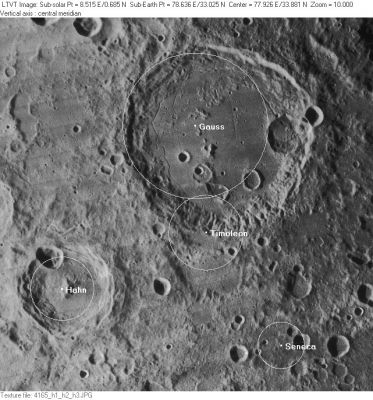Timoleon
Contents
Timoleon
(discontinued [/IAU%20nomenclature IAU] name)Table of Contents
[#Timoleon Timoleon]
[#Timoleon-Images Images]
[#Timoleon-Maps Maps]
[#Timoleon-Description Description]
[#Timoleon-Additional Information Additional Information]
[#Timoleon-Nomenclature Nomenclature]
[#Timoleon-LPOD Articles LPOD Articles]
[#Timoleon-Bibliography Bibliography]
|
Lat: 33.0°N, Long: 78.6°N, Diameter: 70 km, Depth: km, [/R%C3%BCkl%2016 Rükl 16] |
Lunar Orbiter IV-165H The annotations show the positions and diameters of Timoleon, [/Seneca Seneca], [/Gauss Gauss] and [/Hahn Hahn] as listed in [/Named%20Lunar%20Formations Named Lunar Formations]. [/Seneca Seneca] has since been moved.
Images
LPOD Photo Gallery Lunar Orbiter Images
Maps
([/LAC%20zone LAC zone] 28C3) LAC map
Description
Crater south of [/Gauss Gauss], northeast of [/Hahn Hahn].
Additional Information
Nomenclature
- Named for Timoleon (ca. 411–337 BCE), a Greek general and statesman.
- Timoleon appears as catalog entry 137A in in the original [/IAU%20nomenclature IAU nomenclature] of [/Blagg%20and%20M%C3%BCller Blagg and Müller]. The "A" indicates it is a new entry interpolated between the classic names documented in Blagg's [/Collated%20List Collated List]. The name is attributed to the nomenclature committee, with a note that Schmidt called this feature [/Seneca Seneca]. The coordinates are given as +0.822/+0.545 in the [/Xi-Eta Xi-Eta] system with a diameter of 0.040 lunar radii. These values are translated in the title line of this page. There is a note in [/Named%20Lunar%20Formations Named Lunar Formations] that Schröter also had a feature called Timoleon but that it was at +0.875/+0.478 (a position between the modern [/Rayleigh Rayleigh] and [/Urey Urey]).
- [/Whitaker Whitaker] (p. 224) lists Timoleon as a new name introduced by Schmidt. This may be based on a note to features 26 ([/Plutarch Plutarch]), 137 ([/Seneca Seneca]) and 137a on page 169 of the [/Collated%20List Collated List]: "Schmidt's "Plutarch" seems to be identical, or nearly so, with Mädler's and Neison's "Seneca" ; while he calls their "Plutarch" "Timoleon," a new name chosen by himself. Schmidt's "Seneca" is a formation W. of "Hahn," not named by Mädler or Neison" ("W." would be called "east" in the current [/IAU%20directions IAU directions]). In other words, in Blagg's opinion, Schmidt did introduce the name, but for the IAU's [/Plutarch Plutarch], and (as apparently later discovered in the preparation of [/Named%20Lunar%20Formations Named Lunar Formations]), Schröter had used the name earlier, possibly for what Schmidt called "Seneca".
- Timoleon was deleted by [/Gerard%20Kuiper Gerard Kuiper] in [/PLA%20Table%20III Table III] of his [/Photographic%20Lunar%20Atlas Photographic Lunar Atlas]. He regarded it as "scarcely identifiable; not a true formation". Kuiper's changes were approved by the IAU in 1961.
- The name Timoleon is still printed on some modern moonmaps, such as the Hallwag map and others.
LPOD Articles
Bibliography
- Longshaw, Nigel. 2000. "Timoleon", Where are You Now?.
This page has been edited 1 times. The last modification was made by - tychocrater tychocrater on Jun 13, 2009 3:24 pm - mfx3
